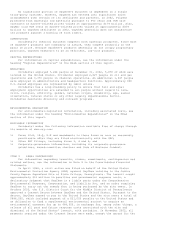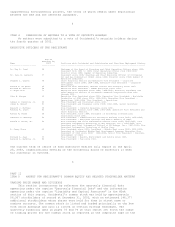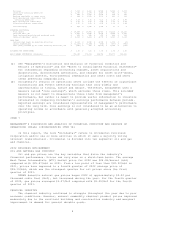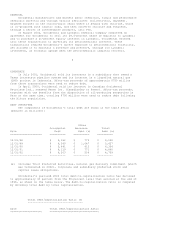Occidental Petroleum 2002 Annual Report Download - page 16
Download and view the complete annual report
Please find page 16 of the 2002 Occidental Petroleum annual report below. You can navigate through the pages in the report by either clicking on the pages listed below, or by using the keyword search tool below to find specific information within the annual report.prices improve and increases when oil prices decline. Overall, Occidental's net
economic benefit from these contracts is greater at higher oil prices.
BUSINESS REVIEW - CHEMICAL
CHLOR-ALKALI
2002 saw increased demand for chlorine in all major market segments,
particularly VCM, propylene oxide and epichlorohydrin. Domestic demand for
co-product caustic soda was flat year over year and exports from the U.S.
declined.
The chlor-alkali industry entered 2002 coming off the lowest operating rate
since 1985. As a result of increased demand, coupled with a full year of
capacity reductions in 2002, industry-operating rates increased from 81 percent
in the fourth quarter of 2001 to a peak of 93 percent in the third quarter of
2002. Annual operating rates increased from 85 percent for 2001 to 89 percent
for 2002.
Prices for chlorine followed the demand curve and increased steadily
throughout the year. Declining total demand for caustic soda coupled with
increased electrochemical unit (ECU) production led to falling caustic soda
prices through the third quarter.
Although markets have improved steadily in 2002, OxyChem has maintained its
Deer Park chlor-alkali production facility in Houston, Texas in a standby mode
pending further strengthening in overall economic conditions and improved demand
for caustic soda.
OxyChem successfully began commercial operation of a 778-megawatt
cogeneration facility in Taft, Louisiana in the fourth quarter of 2002. This
facility provides all of the steam and electric power requirements for the Taft,
Louisiana chlor-alkali plant at a lower cost than if the plant were to generate
its own steam and purchase electricity from a public utility. It sells excess
power in the merchant market.
VINYLS
2002 saw improvement in North American PVC resin demand following a
strengthening trend which began in early 2001. For the year, North American PVC
resin demand grew at a rate of approximately 5 percent. The 2002 market
exhibited strong growth through July, with more moderate growth in the third
quarter, followed by seasonal contraction in the fourth quarter.
As a result of higher demand, together with lower inventory levels, in much
of the chain, industry-operating rates climbed from the low 80 percent levels of
the second half of 2001 to above 90 percent for the second and third quarters of
2002. Although PVC resin capacity remains in oversupply, tightness in VCM and
chlorine feedstocks have constrained vinyls production levels throughout the
year.
Vinyls prices reflected this tightness by rising 14 cents/lb in the first
seven months of 2002. Prices to vinyls export markets peaked somewhat earlier in
the year then retreated during the third quarter, due primarily to a sharp
reduction in Chinese imports. Prices posted improvements in late fourth quarter
as spot buyers anticipated supply constraints for 2003 coupled with an overall
improvement in demand in Southeast Asia.
2003 OUTLOOK
OIL AND GAS
The petroleum industry is highly competitive and subject to significant
volatility due to numerous market forces. Crude oil and natural gas prices are
affected by market fundamentals such as weather, inventory levels, competing
fuel prices, overall demand and the availability of supply.
In the last half of 2002, worldwide oil prices strengthened due to
increasing political and economic turmoil in Venezuela and the growing threat of
conflict with Iraq. Venezuela alone accounts for approximately 13 percent of
total U.S. oil imports. These uncertainties raised concerns about the security
and availability of ample supplies to meet growing demand. In 2003, continued
unrest in Venezuela and the Middle East portend significant volatility for
short-term crude oil prices and continued price uncertainty over the long-term.
If the turmoil continues well into 2003, the result could be a continued
tightening of crude oil supplies and correspondingly higher prices. Conversely,
a lessening of the uncertainties could result in greater crude oil supply and
lower prices.
Sustained high oil prices will significantly impact profitability and
returns for Occidental and other upstream producers. However, the industry has
























